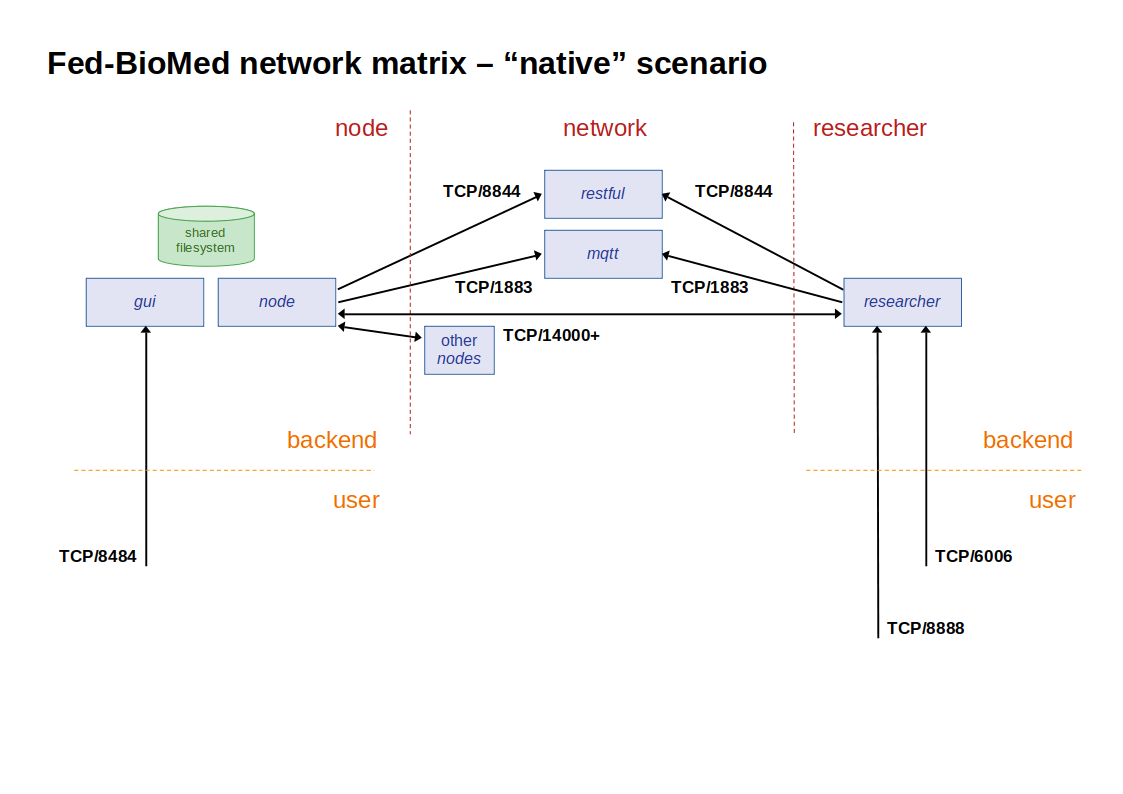Network communication matrix
This page describes the network communications:
- between the Fed-BioMed components (
nodes,networkandresearcher), aka application internal / backend communications - for user access to the Fed-BioMed components GUI
- for Fed-BioMed software installation and docker image build
Communications between the components depend on the deployment scenario: with or without VPN/containers.
Network communications for the setup of host machines and the installation of software requirements are out of the scope of this document. Network communications necessary for the host machines to run (access to DNS, LDAP, etc.) regardless of Fed-BioMed are also out of the scope of this document. They are specific to system configuration and installation processes.
Introduction
Fed-BioMed network communications basic principle is that all communications between components are outbound from one node or from the researcher to the network. There is no direct communication from a node to the researcher, or inbound communications to a node or the researcher.
Nevertheless, future releases will introduce some optional direct communications between the components for using the secure aggregation feature (eg. node/researcher to node/researcher communication for cryptographic material negotiation).
Fed-BioMed provides some optional GUI for the node (node configuration GUI) and the researcher (Jupyter notebook and Tensorboard). Currently, Fed-BioMed does not include secure communications to these GUI components. So they are configured by default to accept only communications from the same machine (localhost).
Software installation
Network communications for software installation cover the Fed-BioMed software installation and setup until the software is ready to be used.
They cover all deployment scenarios. If multiple machines are used, each machine needs to authorize these communications.
- direction is out (outbound communication from the component) or in (inbound communication to the component)
| dir | source machine | destination machine | destination port | service |
|---|---|---|---|---|
| out | component | Internet | TCP/80 | HTTP |
| out | component | Internet | TCP/443 | HTTPS |
"Component" is the node, network or researcher.
For destination machine, it is simpler to authorize outbound communications to all Internet addresses for the required ports during installation. Indeed, several packaging systems are used for installation, with no guarantee of stable IP address used by the packaging server:
- for all deployment scenarios: conda, pip (all components) and yarn/npm (node GUI component) packages
- plus for VPN/containers scenarios: dockerhub images, apt apk and cargo packages, git over https cloning, wget and curl download
Note: when using a VPN/containers scenario, a site with very stringent requirements on node's communication can avoid authorizing the above communications for installation of the node components (node and gui). For that, it needs to build the components docker image on another machine (with the above filter), save the image, copy it to the node machine, load it on the node machine. This scenario is not fully packaged and documented by Fed-BioMed but you can find some guidelines here.
Running without VPN/containers

This part describes the communication matrix for running Fed-BioMed without VPN/containers:
- direction is out (outbound communication from the component) or in (inbound communication to the component)
- type of communication is either backend (between the application components) or user (user access to a component GUI). Command line user access to component from localhost are not noted here. GUI access are noted though recommended default configuration is to give access only from localhost
- status is either mandatory (needed to run Fed-BioMed) or optional (a Fed-BioMed experiment can run without this part)
On the node component (node + gui ):
| dir | source machine | destination machine | destination port | service | type | status | comment |
|---|---|---|---|---|---|---|---|
| out | node | restful | TCP/8080 | HTTP | backend | mandatory | |
| out | node | mqtt | TCP/1883 | MQTT | backend | mandatory | |
| out | node | other nodes + researcher | TCP/14000+ | MP-SPDZ | backend | optional | secagg key negotation |
| in | other nodes + researcher | node | TCP/14000+ | MP-SPDZ | backend | optional | secagg key negotation |
| in | localhost | gui | TCP/8484 | HTTP | user | optional | node GUI |
nodeandguialso need a shared filesystem, so they are usually installed on the same machine.- MP-SPDZ uses port TCP/14000 when one component runs on a machine. It also uses following port numbers when multiple components run on the same machine (one port per component).
On the network component (mqtt + restful):
| dir | source machine | destination machine | destination port | service | type | status | comment |
|---|---|---|---|---|---|---|---|
| in | nodes + researcher | mqtt | TCP/1883 | MQTT | backend | mandatory | |
| in | nodes + researcher | restful | TCP/8080 | HTTP | backend | mandatory |
On the researcher component (researcher):
| dir | source machine | destination machine | destination port | service | type | status | comment |
|---|---|---|---|---|---|---|---|
| out | researcher | restful | TCP/8080 | HTTP | backend | mandatory | |
| out | researcher | mqtt | TCP/1883 | MQTT | backend | mandatory | |
| out | researcher | nodes | TCP/14000+ | MP-SPDZ | backend | optional | secagg key negotation |
| in | nodes | researcher | TCP/14000+ | MP-SPDZ | backend | optional | secagg key negotation |
| in | localhost | researcher | TCP/8888 | HTTP | user | optional | Jupyter |
| in | localhost | researcher | TCP/6006 | HTTP | user | optional | Tensorboard |
Running with VPN/containers

This part describes the communication matrix for running Fed-BioMed with VPN/containers:
- direction is out (outbound communication from the component) or in (inbound communication to the component)
- type of communication is either backend (between the application components) or user (user access to a component GUI). Command line user access to component from localhost are not noted here. GUI access are noted though recommended default configuration is to give access only from localhost
- status is either mandatory (needed to run Fed-BioMed) or optional (a Fed-BioMed experiment can run without this part)
On the node component (node + gui ):
| dir | source machine | destination machine | destination port | service | type | status | comment |
|---|---|---|---|---|---|---|---|
| out | node | vpnserver | UDP/51820 | WireGuard | backend | mandatory | |
| in | localhost | gui | TCP/8484 | HTTP | user | optional | node GUI |
nodeandguialso need a shared filesystem, so they are usually installed on the same machine.
On the network component (vpnserver + mqtt + restful):
| dir | source machine | destination machine | destination port | service | type | status | comment |
|---|---|---|---|---|---|---|---|
| in | nodes + researcher | vpnserver | UDP/51820 | WireGuard | backend | mandatory |
mqttandrestfulalso communicate with thevpnserverthrough a WireGuard tunnel
On the researcher component (researcher):
| dir | source machine | destination machine | destination port | service | type | status | comment |
|---|---|---|---|---|---|---|---|
| out | researcher | vpnserver | UDP/51820 | WireGuard | backend | mandatory | |
| in | localhost | researcher | TCP/8888 | HTTP | user | optional | Jupyter |
| in | localhost | researcher | TCP/6006 | HTTP | user | optional | Tensorboard |
In this scenario, MQTT, restful and MP-SPDZ communications are tunneled within the WireGuard VPN.


